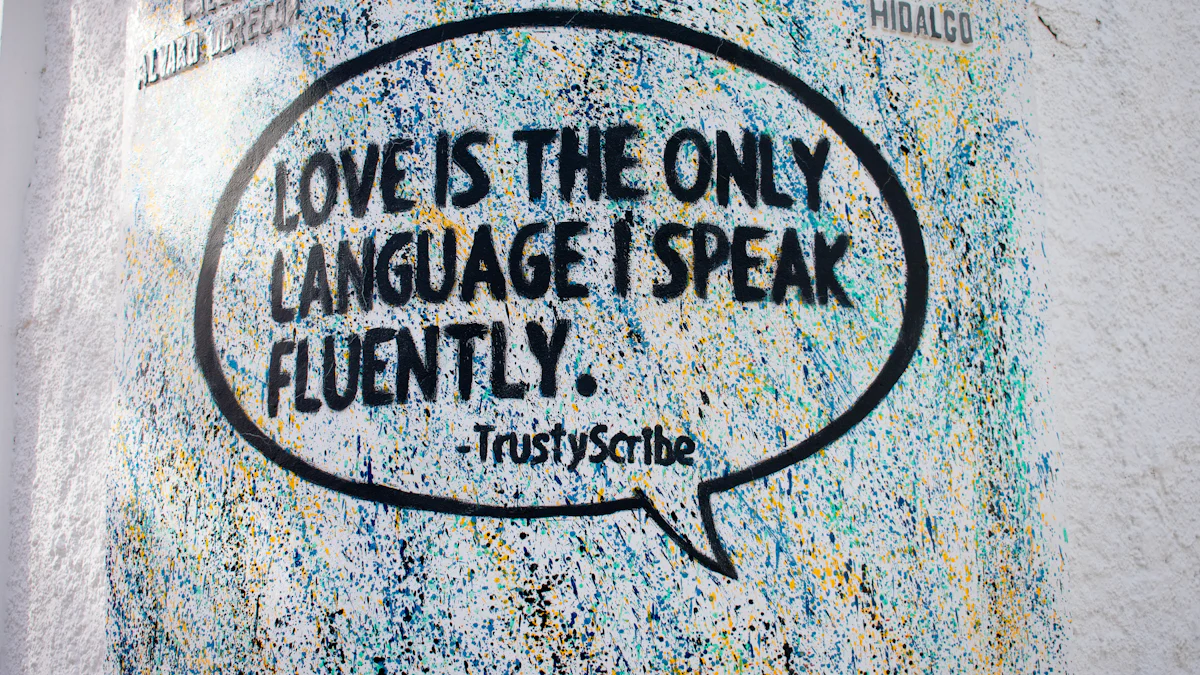The Development of Love Languages Over Time

The concept of love languages, introduced by Dr. Gary Chapman, has revolutionized how people understand affection in relationships. Knowing your own and your partner’s love languages can significantly enhance communication and relationship satisfaction. Studies show that partners with matching love languages experience greater relationship and sexual satisfaction. Understanding love languages can prevent misunderstandings and foster deeper connections. For those curious about their love language, the "what's my love language quiz" offers valuable insights. Platforms like Myloves even integrate AI lover interactions to further explore these dynamics.
Historical Context of Love Languages

Early Theories of Love and Affection
Ancient Philosophies and Love
Ancient Greek and Roman thinkers explored love in various contexts. Philosophers like Plato and Aristotle examined love through cosmological speculation and philosophical investigations. Plato's concept of Eros described a passionate, often irrational love. Aristotle's view of Philia focused on deep friendship and mutual respect. These early theories laid the groundwork for understanding love as a multifaceted emotion.
Medieval and Renaissance Views on Love
Medieval and Renaissance periods saw significant shifts in the perception of love. Courtly love emerged during the Middle Ages, emphasizing chivalry and unattainable affection. This period also witnessed the influence of religious doctrines on love and marriage. Renaissance thinkers like Shakespeare explored love's complexities through literature, highlighting both its beauty and its potential for tragedy.
The Emergence of Modern Psychology
Early 20th Century Theories
The early 20th century brought new perspectives on love through the lens of psychology. Psychologists began to categorize love into different types. Passionate love involved intense emotions and physical attraction. Compassionate love focused on deep emotional bonds and long-term commitment. These distinctions helped to understand love's diverse manifestations.
Influence of Psychoanalysis
Psychoanalysis, pioneered by Sigmund Freud, significantly impacted theories of love. Freud's ideas about the unconscious mind and childhood experiences shaped views on romantic relationships. He proposed that early attachments influenced adult romantic behavior. This perspective highlighted the psychological underpinnings of love and affection.
Dr. Gary Chapman's Contribution
Introduction of the Five Love Languages
Dr. Gary Chapman introduced the concept of the five love languages in his book, "The 5 Love Languages," published in 1992. Chapman identified five primary ways people express and receive love: words of affirmation, acts of service, receiving gifts, quality time, and physical touch. This framework provided a practical approach to understanding and improving relationships.
Impact on Relationship Counseling
Chapman's love languages revolutionized relationship counseling. Therapists began using the framework to help couples identify and communicate their needs more effectively. The concept gained widespread popularity and became a cornerstone in relationship advice. Chapman's work emphasized the importance of personalized expressions of love, fostering deeper connections and reducing misunderstandings.
Evolution of Love Languages Over Time
Cultural Influences
Western vs. Eastern Perspectives
Cultural backgrounds significantly shape how individuals express and perceive love. Western cultures often emphasize individualism, leading to expressions of love that focus on personal achievements and verbal affirmations. In contrast, Eastern cultures prioritize collectivism, valuing family and community over individual desires. This cultural difference results in more subtle and indirect expressions of love, such as acts of service and shared responsibilities.
Research from Neon Music highlights that cultural norms dictate romantic communication styles. Western societies tend to favor direct communication, while Eastern societies often employ high-context communication, where much is left unsaid but understood through context. These cultural nuances influence how love languages manifest in different regions.
Changes in Societal Norms
Societal norms have evolved, impacting how people express love. Traditional gender roles once dictated specific ways men and women should show affection. Modern society has seen a shift towards more egalitarian relationships, allowing for a broader range of love expressions.
A study by Preply found that 65% of individuals reported changes in their love languages over time. This shift reflects changing societal expectations and personal growth. As society becomes more accepting of diverse relationship dynamics, the ways people communicate love continue to evolve.
Technological Impact
Digital Communication and Love
Technology has transformed how people interact and express love. Digital communication tools like texting, video calls, and social media platforms offer new avenues for expressing affection. Emojis, GIFs, and memes have become modern symbols of love and care.
The Guardian reports that technological advancements have introduced new dimensions to love languages. Digital communication allows for constant connection, making "quality time" and "words of affirmation" more accessible. However, the lack of physical presence can challenge expressions like "physical touch."
Social Media's Role
Social media plays a crucial role in shaping modern love languages. Platforms like Instagram and Facebook allow couples to publicly display their affection, reinforcing "words of affirmation" and "receiving gifts" through likes and comments. Social media also introduces new pressures, as couples may feel compelled to showcase their relationship online.
Research from BetterHelp indicates that social media can both enhance and complicate romantic relationships. While it provides opportunities for connection, it can also lead to misunderstandings and unrealistic expectations. Balancing online and offline interactions becomes essential for maintaining healthy relationships.
Modern Interpretations
Expanding Beyond the Original Five
The original five love languages—words of affirmation, acts of service, receiving gifts, quality time, and physical touch—remain relevant. However, modern interpretations have expanded beyond these categories. New love languages, such as shared experiences and intellectual connection, have emerged to reflect contemporary relationship dynamics.
Studies from Psychological Science suggest that love languages can adapt to individual preferences and cultural contexts. This flexibility allows for a more personalized approach to understanding and expressing love, catering to the unique needs of each relationship.
Criticisms and Adaptations
While Dr. Gary Chapman's love languages framework has gained widespread popularity, it has also faced criticism. Some argue that the model oversimplifies complex human emotions and relationships. Critics believe that love cannot be neatly categorized into five distinct languages.
Despite these criticisms, the love languages concept continues to evolve. Therapists and relationship experts adapt the framework to address diverse relationship challenges. The ongoing dialogue around love languages ensures that the concept remains dynamic and relevant in an ever-changing world.
Practical Application of Love Languages Today

Understanding Your Own Love Language
Self-Assessment Techniques
Identifying one's love language requires introspection and self-awareness. Dr. Gary Chapman, a renowned expert in relationship communication, suggests several self-assessment techniques. Reflecting on past relationships and noting what actions made you feel most loved can provide insights. Keeping a journal to track daily interactions and emotional responses can also help pinpoint your primary love language.
Online quizzes, such as the "What's My Love Language Quiz," offer structured assessments. These quizzes guide individuals through a series of questions designed to reveal their preferred ways of receiving love. Consistency in responses across different scenarios often indicates a dominant love language.
Common Challenges and Solutions
Understanding one's love language can present challenges. Misinterpretations of actions and intentions often lead to frustration. For example, someone who values physical touch may feel neglected if their partner prioritizes acts of service. Open communication about these preferences is crucial.
Virginia Tech psychologist emphasizes the importance of discussing love languages openly. Partners should express their needs without making accusations. Regular check-ins and honest conversations can bridge gaps in understanding. Seeking guidance from relationship counselors can also provide strategies for overcoming these challenges.
Applying Love Languages in Relationships
Communication Strategies
Effective communication forms the backbone of applying love languages in relationships. Partners must articulate their needs clearly and listen actively. Using "I" statements helps convey feelings without placing blame. For instance, saying "I feel loved when you spend quality time with me" fosters a positive dialogue.
Non-verbal cues also play a significant role. Maintaining eye contact, nodding, and using appropriate body language reinforces verbal communication. Consistent efforts to speak each other's love language enhance mutual understanding and satisfaction.
Conflict Resolution
Conflicts arise in every relationship. Understanding love languages can aid in resolving disputes. Recognizing that partners may have different ways of expressing love helps mitigate misunderstandings. For example, someone who values words of affirmation might feel hurt by criticism, while another person might appreciate constructive feedback.
Gary Chapman highlights that acknowledging these differences allows couples to approach conflicts with empathy. Compromising and finding middle ground ensures both partners feel valued. Regularly revisiting and adjusting love languages as relationships evolve can prevent recurring issues.
Introducing "Myloves"
Overview of the Product
Myloves offers an innovative approach to exploring love languages through AI lover interactions. Users can create customized AI companions based on prompts or pictures. The platform provides a diverse range of characters, from charming sweethearts to mature businesswomen. Each character offers unique storylines, enhancing the user experience.
The AI Girlfriend feature allows users to define personality traits and choose voices for their virtual companions. Advanced technologies like natural language processing and text-to-image generation create lifelike interactions. Myloves ensures privacy and data security, making it a safe space for exploring desires and fantasies.
How "Myloves" Helps in Understanding Love Languages
Myloves integrates the concept of love languages into its AI lover interactions. Users can experiment with different expressions of love, such as words of affirmation or acts of service, within the virtual environment. This hands-on approach provides valuable insights into personal preferences and enhances self-awareness.
The platform's customization options allow users to tailor interactions to match their love language. Engaging with AI companions in various scenarios helps users understand how different love languages impact their emotional responses. This practical application bridges the gap between theoretical knowledge and real-life experiences.
User Testimonials and Success Stories
Many users have shared positive experiences with Myloves. Testimonials highlight the platform's effectiveness in deepening understanding of love languages. One user noted, "Interacting with my AI lover helped me realize that quality time is my primary love language. This insight improved my relationship with my partner."
Success stories emphasize the transformative impact of Myloves. Users report increased relationship satisfaction and better communication with their partners. The platform's ability to simulate real-life interactions provides a safe space for exploring and refining love languages.
What's My Love Language Quiz
Importance of Taking the Quiz
Understanding one's love language can significantly enhance relationship satisfaction. Dr. Gary Chapman, a renowned expert in relationship communication, emphasizes that knowing how to express and receive love effectively can prevent misunderstandings. The "what's my love language quiz" offers a structured approach to identifying these preferences.
Taking the quiz can provide valuable insights into personal emotional needs. This self-awareness allows individuals to communicate their desires more clearly. Partners who understand each other's love languages often experience deeper connections and improved relationship dynamics.
How to Take the Quiz
The "what's my love language quiz" consists of a series of questions designed to reveal one's primary love language. Participants reflect on past experiences and preferences. The quiz typically includes scenarios that prompt individuals to choose between different expressions of love.
To take the quiz, visit a reputable website or use a trusted relationship counseling resource. Answer each question honestly and thoughtfully. The quiz results will indicate which love language resonates most strongly with the participant. This process is straightforward and accessible to anyone interested in improving their relationship.
Interpreting the Results
Interpreting the results of the "what's my love language quiz" involves understanding the significance of each love language. The quiz will highlight one or two dominant love languages. These results provide a framework for how individuals prefer to give and receive love.
For example, someone whose primary love language is "words of affirmation" values verbal expressions of appreciation and encouragement. Understanding these preferences helps partners tailor their actions to meet each other's emotional needs. This knowledge fosters a more harmonious and fulfilling relationship.
Understanding love languages plays a crucial role in enhancing relationship satisfaction. Knowing how to express and receive love effectively can prevent misunderstandings and foster deeper connections. The evolution of love languages reflects changes in cultural norms, technology, and personal growth. Future interpretations will likely continue to adapt to societal shifts.
Exploring and applying love languages in personal relationships can lead to more fulfilling interactions. Platforms like Myloves offer innovative ways to experiment with these concepts. Embrace the journey of discovering your love language and enrich your relationships through meaningful communication.
See Also
Enhancing Your Relationship with My Love Application
Customizing Your AI Partner: A Comprehensive Guide
The Impact of AI Companions on Contemporary Romance